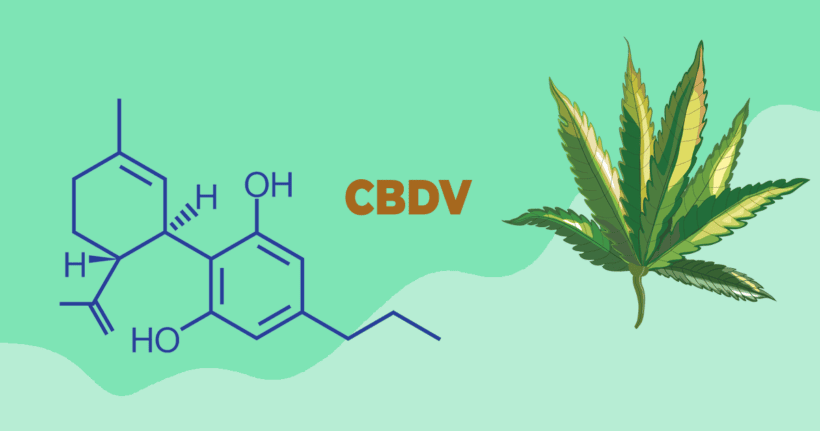Cannabidivarin (CBDV) is one of the dozens of cannabinoids found in cannabis. Like other minor cannabinoids, CBDV concentrations in cannabis are much smaller than CBD and THC.
CBDV belongs to the rarest group of phytocannabinoids called varins, which have fewer carbon atoms than their regular counterparts (1). It’s derived from cannabigerovarinic acid (CBGVa), the varinic version of the “mother cannabinoid” CBGa.
Let’s take a closer look at CBDV, how it differs from CBD, and its potential to support your health and wellness.
Table of Contents
CBDV vs. CBD
| CBDV | CBD | |
| Intoxicating? | No | No |
| Key Potential Benefits | Anti-inflammatory, anti-seizure, anti-nausea, neuroprotective | Anti-inflammatory, pain relief, anti-seizure, anti-anxiety, anti-nausea, neuroprotective, anticancer, antipsychotic |
| How They Work | TRP channels, GPR55 & GPR6 receptors | TRP channels, GPR55 & GPR6 receptors, serotonin receptor, and more |
You’re probably aware of the many uses of CBD for sleep, anxiety, pain, and more. For most people, CBDV is far less familiar, although it was first identified by researchers over 50 years ago (2).
Both CBD and CBDV are non-intoxicating cannabinoids, meaning they can’t get you high. Their molecular structures are also very similar, which is why CBDV operates in a manner akin to CBD and presents some of the same potential benefits.
The main difference is that CBDV has only three carbon atoms on its side chain whereas CBD has five, so it’s not 100% identical (1). It’s the same case for THCV, the varinic version of THC.
Potential Effects & Benefits
Research on CBDV is in its early stages. So far, it seems to hold the most promise for epilepsy, autism spectrum disorder (ASD), and neurodegenerative conditions such as Alzheimer’s disease. Here’s what we know so far:
Epilepsy
CBDV seems to be especially effective for relieving epileptic seizures. The evidence is so promising that GW Pharmaceuticals (the same company that developed the antiepileptic CBD drug Epidiolex) is testing a CBDV-based drug for epilepsy and has filed related patents.
Gw Pharmaceuticals sponsored several clinical trials of CBDV:
- A 2022 study in children with epilepsy caused by a rare condition called Rett syndrome found that CBDV reduced seizure frequency without serious side effects (3).
- A 2021 study of CBDV as an add-on to standard medication in 162 adults with focal seizures had more conflicting results. CBDV resulted in 40.5% reduction of seizures but was only a bit better than placebo (37.7%), suggesting the need for further research (4)
Autism Spectrum Disorder
CBDV may also offer relief for symptoms of autism spectrum disorder (ASD), an incurable condition with difficult-to-manage symptoms.
In particular, researchers found that CBDV may change the brain’s balance of excitatory (stimulating) and inhibitory (calming) chemicals glutamate and GABA. Dysregulation of these neurotransmitters is believed to be a key component of ASD (5).
In one 2019 rat study, CBDV improved autism-like behaviors by improving endocannabinoid signaling and counteracting neuroinflammation (6). Another 2019 study in 34 healthy and autistic adults found that a single dose of CBDV shifted the levels of glutamate in some parts of the brain but the researchers did not measure any changes in ASD symptoms (7).
A clinical trial supported by GW Pharmaceuticals is currently underway to examine whether CBDV could relieve irritability in children with ASD (8).
Duchenne Muscular Dystrophy
Duchenne Muscular Dystrophy (DMD) is a genetic disease common in boys that leads to muscular weakness. It starts in early childhood and affects the entire body. A 2019 study in dystrophic mice found that CBDV improved some aspects of the disease, including inflammation and impaired cell differentiation (9).
Reducing Inflammation
Like most phytocannabinoids, CBDV also appears to have anti-inflammatory properties. For example, a 2019 study found that CBDV effectively reduced inflammation caused by ulcerative colitis in both mice and human tissue samples (10).
In another 2019 study on mice, researchers reported that CBDV treatment reduced inflammation and supported the formation of healthy muscle tissue (11).
Neuroprotection
CBDV also shows early promise for neurodegenerative conditions that damage brain cells:
- A 2019 study of several phytocannabinoids found that CBDV may protect neurons in several ways, suggesting potential benefits for Alzheimer’s and similar conditions (12)
- A 2021 study found that CBDV and CBG protected cells of the blood-brain barrier (BBB) from stroke (13)
- A 2022 study in worms found that CBDV protected brain cells from damage by preventing the accumulation of a protein that’s linked to Parkinson’s disease (14)
Reducing Nausea
CBDV also appears to have anti-nausea effects, which are common to many phytocannabinoids (15).
How Does CBDV Work?
Like CBD, CBDV doesn’t bind to the main cannabinoid receptors (CB1 and CB2). So far, research has found that it works by: (16)
- Interacting with TRP channels, which are involved in inflammation and pain
- Blocking GPR55, considered by many to be the third cannabinoid receptor
- Interacting with GPR6, another “orphan” receptor that seems to interact with cannabinoids
- Potentially inhibiting DAGL, the enzyme our bodies need to make the endocannabinoid 2-AG
These mechanisms are similar to CBD, which isn’t surprising given CBDV’s close molecular structure.
Is CBDV Safe?
CBDV hasn’t been specifically studied for safety in humans, so we can’t say for certain what the risks and possible side effects may be. The available human trials found mostly minor side effects:
- The 2021 study reported diarrhea, nausea, and drowsiness. Three people (4%) taking CBDV discontinued the treatment because of a rash (4).
- The 2022 study reported sleepiness and drooling as the most common side effects linked directly to CBDV (3).
Bottom line: If you try CBDV, it’s best to start low and go slow, as you should with any cannabinoid (17). Take only as much as needed to achieve the results you’re looking for.
Types of CBDV Products
CBDV products are still somewhat limited, but they’re becoming more widely available as interest in this uncommon cannabinoid grows.
Some CBD brands are beginning to offer CBDV products, including:
- CBDV oil – Most CBDV oils are a combination of CBDV along with CBD and other cannabinoids, but some companies also offer CBDV isolate.
- CBDV gummies and capsules – If you prefer the convenience of gummies or capsules over oil, some CBD brands now offer CBDV in these forms. The potency varies widely, so check the label to find out how many mg of CBDV you’re getting per gummy or capsule.
Most of these products are only available online. As always, we recommend choosing reputable brands and checking third-party test results to ensure you get an accurate product.
Cannabis Strains High in CBDV
CBDV is usually present in low concentrations in most cannabis strains. However, some plants contain higher levels of CBDV naturally, especially strains originating in Asia and Africa (17).
A few examples of high-CBDV strains to look for include:
- Euphoria
- Royal CBDv
- Royal Medic
- Forbidden V CBDV
- Dance World
- Pine Walker
CBDV: Another Valuable Member of the Cannabinoid Family
CBDV may have many similarities to CBD in its structure and effects, but it also has some unique properties that make it stand out among phytocannabinoids.
Watch out for exaggerated health claims as we still need much more research to learn exactly how CBDV works and what it can do. Still, it’s clear that CBDV has great potential to provide relief for some neurological conditions.
If you’re interested in trying CBDV, we recommend opting for a tincture, gummies, or capsules from a reputable CBD brand.
Sources
- Walsh, Kenneth B., Amanda E. McKinney, and Andrea E. Holmes. “Minor cannabinoids: biosynthesis, molecular pharmacology and potential therapeutic uses.” Frontiers in Pharmacology 12 (2021): 777804.
- Merkus, Frans WHM. “Cannabivarin and tetrahydrocannabivarin, two new constituents of hashish.” Nature 232.5312 (1971): 579-580.
- Hurley, Ellen N., et al. “Efficacy and safety of cannabidivarin treatment of epilepsy in girls with Rett syndrome: A phase 1 clinical trial.” Epilepsia 63.7 (2022): 1736-1747.
- Brodie, Martin J., et al. “A phase 2 randomized controlled trial of the efficacy and safety of cannabidivarin as add-on therapy in participants with inadequately controlled focal seizures.” Cannabis and cannabinoid research 6.6 (2021): 528-536.
- Horder, Jamie, et al. “Glutamate and GABA in autism spectrum disorder—a translational magnetic resonance spectroscopy study in man and rodent models.” Translational psychiatry 8.1 (2018): 106.
- Zamberletti, Erica, et al. “Cannabidivarin treatment ameliorates autism-like behaviors and restores hippocampal endocannabinoid system and glia alterations induced by prenatal valproic acid exposure in rats.” Frontiers in cellular neuroscience 13 (2019): 367.
- Pretzsch, Charlotte M., et al. “Effects of cannabidivarin (CBDV) on brain excitation and inhibition systems in adults with and without Autism Spectrum Disorder (ASD): a single dose trial during magnetic resonance spectroscopy.” Translational psychiatry 9.1 (2019): 313.
- Hollander, Eric. Cannabidivarin (CBDV) Versus Placebo in Children with Autism Spectrum Disorder (ASD). Albert Eintsein College of Medicine, Inc., 2018.
- Iannotti, Fabio Arturo, et al. “Effects of non‐euphoric plant cannabinoids on muscle quality and performance of dystrophic mdx mice.” British journal of pharmacology 176.10 (2019): 1568-1584.
- Pagano, E., et al. “The non-euphoric phytocannabinoid cannabidivarin counteracts intestinal inflammation in mice and cytokine expression in biopsies from UC pediatric patients.” Pharmacological Research 149 (2019): 104464.
- Iannotti, Fabio Arturo, et al. “Effects of non‐euphoric plant cannabinoids on muscle quality and performance of dystrophic mdx mice.” British journal of pharmacology 176.10 (2019): 1568-1584.
- Schubert, David, et al. “Efficacy of cannabinoids in a pre-clinical drug-screening platform for Alzheimer’s disease.” Molecular neurobiology 56 (2019): 7719-7730.
- Stone, Nicole L., Timothy J. England, and Saoirse E. O’Sullivan. “Protective effects of cannabidivarin and cannabigerol on cells of the blood–brain barrier under ischemic conditions.” Cannabis and Cannabinoid Research 6.4 (2021): 315-326.
- Wang, Fangru, et al. “Cannabidivarin alleviates α‐synuclein aggregation via DAF‐16 in Caenorhabditis elegans.” The FASEB Journal 37.2 (2023): e22735.
- Rock, Erin M., et al. “Evaluation of the potential of the phytocannabinoids, cannabidivarin (CBDV) and Δ9‐tetrahydrocannabivarin (THCV), to produce CB1 receptor inverse agonism symptoms of nausea in rats.” British journal of pharmacology 170.3 (2013): 671-678.
- Alves, Patrícia, et al. “Cannabis sativa: Much more beyond Δ9-tetrahydrocannabinol.” Pharmacological research 157 (2020): 104822.
- Lucas, Catherine J., Peter Galettis, and Jennifer Schneider. “The pharmacokinetics and the pharmacodynamics of cannabinoids.” British journal of clinical pharmacology 84.11 (2018): 2477-2482.
- Kim, Kwang Sik. “How pathogens penetrate the blood-brain barrier.” Microbe 9 (2014): 487-92.
- https://www.globenewswire.com/news-release/2015/05/06/732705/10132893/en/GW-Pharmaceuticals-Initiates-Phase-2-Clinical-Study-of-Cannabidivarin-CBDV-in-Epilepsy.html

Gleb is a freelance writer from Vancouver, Canada specializing in CBD and cannabis. He’s read thousands of studies on CBD and other supplements, helping him translate complex science into plain language. Gleb has tried and reviewed dozens of CBD brands and products, written third-party testing reports, and knows the CBD industry inside and out. When not writing, he likes to kickbox, travel, and tell everyone how awesome intermittent fasting is.





